Plants have the remarkable ability to prepare their own food through a process called photosynthesis, in which they use sunlight, water, and carbon dioxide to produce carbohydrates and oxygen.
In contrast, animals are unable to perform photosynthesis, so they must acquire their food from external sources. This food can come from plants directly or indirectly through the consumption of other animals that have consumed plants.
All living organisms, including humans, require food for various essential purposes, including growth, repair of tissues, and providing energy for bodily functions.
The study of animal nutrition involves understanding the requirements for nutrients, how food is ingested, and how it is utilised within the body.
Table of Contents
Components of Food-
Food consists of various components that are essential for providing the necessary nutrients and energy for living organisms. These components include-
- Carbohydrates
- Proteins
- Fats (Lipids)
- Vitamins
- Minerals
- Water
These components serve distinct roles in the body and are vital for maintaining health and overall well-being.
- Carbohydrates, for example, are a primary source of energy for the body.
- Proteins are essential for growth, repair, and the functioning of various bodily processes.
- Fats provide concentrated energy and play a role in insulation and protecting organs.
- Vitamins and minerals are required in smaller quantities but are essential for various biochemical reactions and maintaining overall health.
- Water is a fundamental component for all living organisms and plays a critical role in various bodily functions.
Also Check – Rapid Revision – Class 7 Science -Chapter 2 – Nutrition in Animals – Complete Notes
Digestion of Complex Substances
- The components of food, such as carbohydrates, are often complex substances that cannot be directly utilised by the body.
- Digestion is the process by which these complex components are broken down into simpler substances that can be absorbed and utilised by the body.
- This breakdown process involves various enzymes and chemical reactions occurring in the digestive system.
- Ultimately, digestion allows the body to extract essential nutrients from food and convert them into forms that can be used for energy, growth, and repair.
Also Check – Nutrition in Animals – Definition and Explanation of Important Keywords
Different Ways of Taking Food
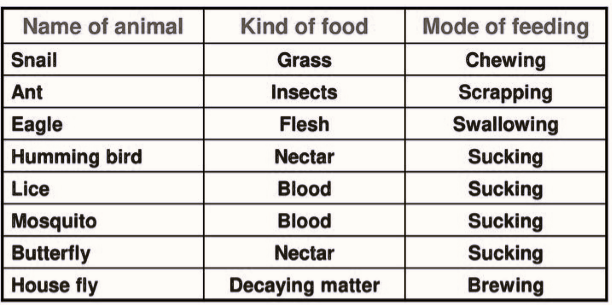
- The mode of taking food into the body varies among different organisms, reflecting their specific adaptations.
- Bees and hummingbirds, for example, feed on nectar from plants, which provides them with sugars and energy.
- Human infants and many other animals receive nourishment from their mother’s milk during early stages of life.
- Some predators, like snakes, have adapted to swallow their prey whole, and their digestive system is specialised for breaking down whole animals.
- Certain aquatic animals have evolved to filter tiny food particles from the water, allowing them to feed on plankton or other small organisms suspended in the aquatic environment.
Also Check – Chapter 2 – Nutrition in Animals Textbook Exercise -(Solved)
Digestion in Humans
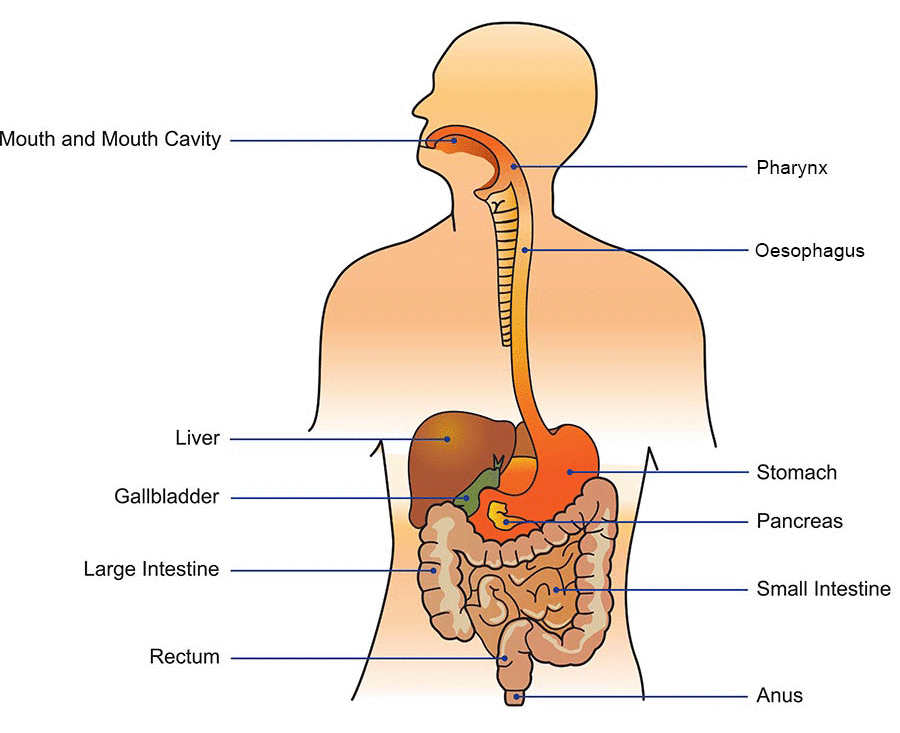
Flowchart for digestion in humans
Ingestion (Eating Food)
Food enters the mouth.
Chewing (Mechanical Digestion)
Teeth break down food into smaller pieces.
Saliva (Chemical Digestion)
Salivary glands release saliva.
Saliva contains enzymes that start breaking down carbohydrates.
Swallowing
Tongue pushes food to the back of the mouth.
Food enters the oesophagus.
Oesophagus
Muscles in the oesophagus push food downward.
Stomach
Food enters the stomach.
Stomach releases gastric juices containing acid and enzymes.
Acid helps kill bacteria.
Enzymes begin digesting proteins.
Small Intestine
Partially digested food moves to the small intestine.
Liver releases bile, stored in the gallbladder, to break down fats.
Pancreas releases enzymes to digest carbohydrates, fats, and proteins.
Absorption
Villi in the small intestine absorb nutrients.
Nutrients enter the bloodstream and are carried to cells throughout the body.
Large Intestine
Undigested food moves to the large intestine.
Water and some minerals are absorbed here.
Remaining waste forms faeces.
Rectum
Faecal matter is stored in the rectum.
Egestion (Elimination)
Faeces are eliminated from the body through the anus.
Energy Release
Nutrients absorbed from the small intestine are used by cells for energy.
Also Check – Class 7- Chapter 2 – Nutrition in Animals – 4 Worksheets Solved and Unsolved
- The process of digestion in humans is a complex and crucial part of the digestive system. It involves the breakdown of ingested food into simpler substances that can be absorbed and utilised by the body.
- The digestive journey begins in the mouth, where food is taken in. The mouth, also known as the buccal cavity, is where mechanical digestion begins. This involves the physical breakdown of food as it is chewed by the teeth. Saliva, produced by the salivary glands, is also introduced in the mouth. Saliva contains enzymes like amylase, which initiates the chemical digestion of carbohydrates by breaking them down into simpler sugars.
- After being chewed and mixed with saliva, the food forms a soft mass called a bolus, which is then swallowed. It passes through the food pipe or oesophagus, a muscular tube that connects the mouth to the stomach. The oesophagus contracts in a coordinated manner to push the bolus downward into the stomach.
- The stomach plays a crucial role in digestion. It has a thick muscular wall and produces gastric juices that contain hydrochloric acid and digestive enzymes. These gastric juices help in the chemical breakdown of proteins in the food. The stomach also churns the food, mixing it with gastric juices to form a semi-liquid mixture called chyme.
- From the stomach, the partially digested food moves into the small intestine, which is the longest part of the digestive tract, measuring about 7.5 metres. Here, digestion continues with the help of digestive enzymes produced by the pancreas and bile from the liver. These enzymes break down carbohydrates, proteins, and fats into simpler substances like glucose, amino acids, and fatty acids, respectively.
- The inner walls of the small intestine are lined with thousands of tiny finger-like projections called villi. These villi greatly increase the surface area for absorption of digested nutrients into the bloodstream. Nutrients like glucose and amino acids are absorbed into the bloodstream and transported to various parts of the body, where they are used for growth, repair, and energy production. This process is called assimilation.
- The remaining undigested and unabsorbed food materials move into the large intestine. The large intestine is shorter and wider than the small intestine and is about 1.5 metres long. Its primary function is to absorb water and some salts from the undigested food, turning it into a semi-solid mass called faeces.
- The faeces are stored in the rectum, the last part of the large intestine, until they are ready to be eliminated from the body through the anus. This process is known as defecation.
- The entire pathway from the mouth to the anus, which includes the buccal cavity, oesophagus, stomach, small intestine, large intestine, rectum, and anus, is collectively called the alimentary canal or digestive tract. It is a remarkably long and intricately designed system that ensures the efficient digestion and absorption of nutrients from the food we consume.
Also Check – To Understand How Hummingbirds Feed, Think of Them As ‘Feathered Bees’
The Mouth and Buccal Cavity
- The mouth serves as the entry point for food into the body, a process known as ingestion.
- Mechanical digestion begins in the mouth when we chew food using our teeth. This action breaks down food into smaller, more manageable pieces.
- Our teeth are specialised for different functions, such as biting, cutting, piercing, tearing, and grinding. These functions are reflected in the different types of teeth, including incisors, canines, premolars, and molars.
- Each tooth is anchored in its own socket within the gums.
- This diversity in tooth types allows us to efficiently process a variety of foods, from tearing into meat with sharp canines to grinding down plant material with molars.
Teeth and Their Functions
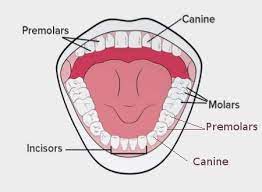
Teeth are specialised structures found in the mouth that play a crucial role in the mechanical breakdown of food during digestion. Humans have different types of teeth, each with its unique shape and function. The various types of teeth are-
- Incisors- Incisors are the front teeth in both the upper and lower jaws. They have a flat, chisel-like shape with a sharp edge. Incisors are designed for cutting and biting food. They are particularly useful for slicing through food items like fruits and vegetables.
- Canines- Canines are the pointed, sharp teeth located just behind the incisors. They have a more conical shape. Canines are well-suited for tearing food, such as when you bite into a piece of meat or tear into tougher items.
- Premolars- Premolars are located behind the canines and have a flat surface with multiple cusps. They are responsible for grinding and crushing food, especially foods that require more chewing, like grains and certain vegetables.
- Molars- Molars are the large, flat teeth at the back of the mouth. They have a broader surface with multiple cusps. Molars are essential for the grinding and crushing of food into smaller, more digestible particles. They are particularly effective for breaking down tough or fibrous foods.
Also Check – Activity -Arrangement of teeth and different type of teeth
The Role of Teeth in Digestion
The process of digestion begins in the mouth, where food is broken down both mechanically and chemically-
- Mechanical Digestion- The teeth contribute significantly to mechanical digestion. They help break down food into smaller pieces, increasing the surface area for enzymatic action. This initial breakdown of food makes it easier for enzymes in the digestive system to access and digest nutrients.
- Chemical Digestion- While chewing, food mixes with saliva, which contains enzymes like amylase. Amylase starts the chemical digestion of carbohydrates, converting starches into simpler sugars. This process is the first step in converting complex nutrients into forms that can be absorbed by the body.
Saliva and Salivary Glands
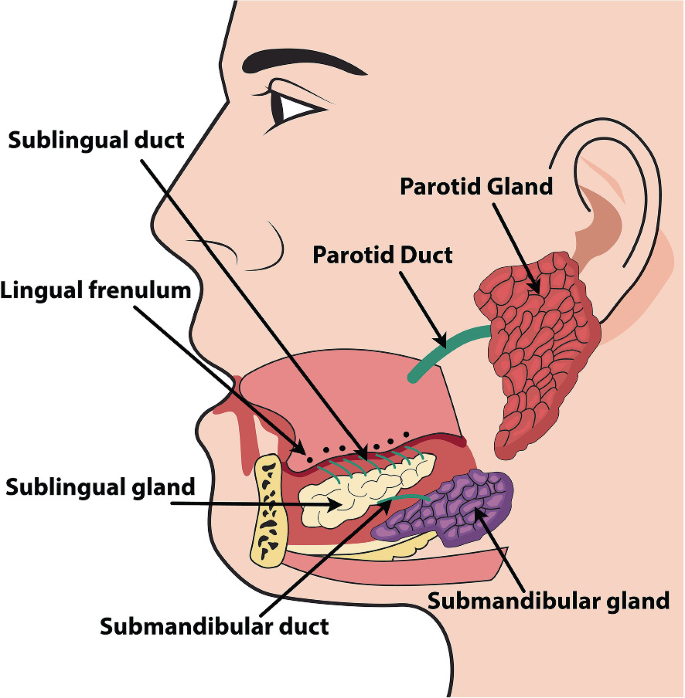
- Saliva is a crucial component in the process of digestion. The mouth houses salivary glands that secrete saliva.
Saliva serves several important functions in digestion-
- It moistens the food, making it easier to chew and swallow.
- Saliva contains enzymes, like amylase, that initiate the breakdown of complex carbohydrates (starches) into simpler sugars.
- Saliva also helps in the initial stages of chemical digestion, preparing food for further processing in the stomach and small intestine.
Also Check – Activity – Effect of saliva on starch – Class 7
Tongue and Taste Buds-
- The tongue is a muscular organ located in the buccal cavity (mouth).
- It is attached at the back to the floor of the buccal cavity, allowing it to move in various directions.
Also Check – Note on Tongue Taste Regions: Recent Research Debunks Traditional Map
The tongue serves several functions-
- It is essential for speech and articulation.
- During chewing, the tongue mixes saliva with food, aiding in the swallowing process.
- The tongue contains taste buds, specialised sensory cells, that detect different tastes in food- sweet, salty, sour, and bitter.
Milk Teeth and Permanent Teeth

- Humans, like many mammals, undergo a two-stage process of tooth development during their lifetime.
- The first set of teeth that develop in infancy and early childhood are referred to as “milk teeth” or “primary teeth.”
- These milk teeth typically begin to erupt around six months of age and continue to emerge until around the age of three.
- Milk teeth serve an essential role in a child’s early development. They allow for biting and chewing food, enabling proper nutrition.
- However, as a child grows, these milk teeth gradually become loose and eventually fall out. This process typically occurs between the ages of six to eight years.
- The loss of milk teeth is a natural part of tooth development and is often followed by the emergence of a second set of teeth, known as “permanent teeth.”
- Permanent teeth are intended to last throughout a person’s life, and they begin to emerge as the milk teeth fall out. The transition from milk teeth to permanent teeth is a crucial milestone in dental development.
- While permanent teeth are expected to remain functional for a lifetime, they may be at risk of damage or loss due to factors such as dental diseases, accidents, or aging.
- Dental care and hygiene are essential to maintaining the health and longevity of both milk and permanent teeth. Regular dental check-ups and proper oral hygiene practices are vital to overall oral health.
Tooth Decay and its Causes
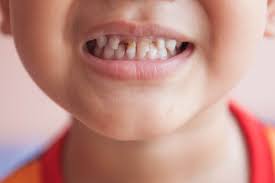
Tooth decay, also known as dental caries or cavities, is a common dental problem caused by the breakdown of tooth structure. Here’s an in-depth explanation of tooth decay and its causes-
- Tooth decay occurs when harmful bacteria in the mouth interact with sugars from leftover food, leading to the production of acids.
- These acids gradually erode the enamel (the outer protective layer) of teeth, leading to cavities or holes in the teeth.
The Role of Bacteria
- The human mouth naturally contains bacteria, but most of them are not harmful.
- If we don’t maintain proper oral hygiene, harmful bacteria can thrive and grow in the mouth.
- These harmful bacteria feed on the sugars left on our teeth after consuming food, especially sugary foods like chocolates, sweets, and soft drinks.
- As they feed, these bacteria produce acids as byproducts.
Acid Formation and Tooth Damage
- The acids produced by the bacteria are corrosive and gradually weaken the enamel.
- Over time, this acidic environment leads to demineralization, where essential minerals like calcium and phosphate are stripped from the tooth’s surface.
- The demineralization process weakens the enamel, making it more susceptible to damage.
Consequences of Tooth Decay
- If left untreated, tooth decay can cause severe dental problems, including toothache, sensitivity, and eventual tooth loss.
- In extreme cases, untreated decay can lead to gum disease, abscesses, and other serious oral health issues.
Prevention and Maintenance
To prevent tooth decay, it is crucial to maintain good oral hygiene practices-
- Brush your teeth with toothpaste at least twice a day, preferably after meals.
- Use dental floss to remove trapped food particles between teeth.
- Rinse your mouth with water after consuming sugary or acidic foods or drinks.
- Limit the consumption of sugary snacks and drinks, especially between meals.
- Visit a dentist regularly for check-ups and professional cleanings.
Swallowing Mechanism and Prevention of Choking
- When eating or drinking, there’s a risk of food particles entering the windpipe (trachea), which carries air from the nostrils to the lungs.
- To prevent this, our body has a protective mechanism.
- During the act of swallowing, a flap-like valve called the epiglottis closes off the passage to the windpipe (trachea).
- This ensures that food and liquids enter the oesophagus (food pipe) and continue their journey to the stomach, rather than going down the windpipe.
- If, by chance, food does enter the windpipe, it triggers reflexes such as coughing, hiccups, or a choking sensation to expel the foreign material and protect the airway.
Digestive Process in the Oesophagus and Stomach
In this section, we will explore the journey of food from the food pipe (oesophagus) into the stomach and understand the vital role played by the stomach in digestion.
The Food Pipe (Oesophagus)
- After food is ingested in the mouth, it travels through a continuous canal called the alimentary canal or digestive tract.
- One key component of this canal is the food pipe or oesophagus.
- The oesophagus is a muscular tube that runs along the neck and chest, connecting the mouth to the stomach.
- Food is propelled down the oesophagus through coordinated muscle contractions, a process known as peristalsis.
- Peristalsis ensures that food reaches the stomach smoothly (as depicted in Fig. 2.7).
Vomiting Reflex
- Occasionally, our stomach may reject food, leading to vomiting.
- Vomiting is a natural reflex that expels the contents of the stomach back up through the oesophagus and out of the mouth.
- This reflex can be triggered by various factors, such as the consumption of spoiled or contaminated food, overeating, or the body’s response to harmful substances.
- Vomiting helps remove potentially harmful or indigestible materials from the stomach.
The Stomach
- The stomach is a crucial organ in the digestive system and plays a pivotal role in food processing.
- It is a muscular, thick-walled organ with a unique shape resembling a flattened J.
- Positioned between the oesophagus and the small intestine, the stomach receives food from the food pipe at one end and connects to the small intestine at the other.
Functions of the Stomach
Secretion of Mucus
- The inner lining of the stomach secretes a protective layer of mucus. This mucus serves to shield the stomach lining from the corrosive effects of stomach acid and digestive enzymes.
Production of Hydrochloric Acid
- The stomach produces hydrochloric acid, creating an acidic environment. This acidic environment serves several purposes-
- It helps to kill many harmful bacteria or pathogens that might enter with the ingested food.
- The acidic medium is essential for activating digestive enzymes in the stomach.
Digestive Juices
- The stomach also secretes digestive juices, including enzymes such as pepsin. These enzymes play a critical role in breaking down proteins into simpler substances, known as peptides.
Protein Digestion-
- The primary function of the stomach is to begin the digestion of proteins present in the food.
- Digestive enzymes, particularly pepsin, start the process of breaking down complex protein molecules into smaller peptide fragments.
- This initial breakdown of proteins is a vital step in the overall digestive process.
Discovery of Stomach Function
- In 1822, Alexis St. Martin suffered a gunshot injury that created a hole in his stomach.
- He was treated by Dr. William Beaumont, who couldn’t close the hole properly and used a bandage instead.
- This allowed Dr. Beaumont to make observations about stomach function through the hole.
- Dr. Beaumont found that the stomach churns food and secretes digestive fluids.
- The stomach only empties its contents into the intestine once digestion is complete.
The Small Intestine and its Role in Digestion
In this section, we will delve into the structure and functions of the small intestine, which is a critical part of the digestive system responsible for the absorption and further digestion of food.
Structure of the Small Intestine-
- The small intestine is a highly coiled tube, approximately 7.5 metres long in humans.
- Its coiled structure provides a substantial surface area for the efficient absorption of nutrients.
- The inner walls of the small intestine are lined with finger-like projections known as villi (singular- villus).
- Villi further increases the surface area, facilitating the absorption of digested food components into the bloodstream.
Digestive Secretions-
- The small intestine receives essential secretions from two vital accessory organs- the liver and the pancreas.
- The liver, a reddish-brown gland located in the upper abdomen on the right side, is the largest gland in the body.
- It produces bile juice, which is stored in a sac called the gallbladder.
- Bile plays a crucial role in the digestion of fats by emulsifying them, breaking them down into smaller droplets for easier digestion.
- The pancreas, a large cream-coloured gland situated just below the stomach, secretes pancreatic juice.
- Pancreatic juice contains enzymes that act on carbohydrates, fats, and proteins, converting them into simpler forms.
Carbohydrate, Fat, and Protein Digestion-
- As the partially digested food enters the lower part of the small intestine, the process of digestion continues.
- Carbohydrates are further broken down into simple sugars like glucose.
- Fats are broken into fatty acids and glycerol.
- Proteins are broken down into amino acids.
- This thorough breakdown of food molecules is essential to extract all available nutrients.
Absorption in the Small Intestine-
- After digestion, the digested food components are ready for absorption.
- The inner walls of the small intestine, lined with villi, play a pivotal role in this process.
- Villi increase the surface area for absorption, making it highly efficient.
- Each villus has a network of thin blood vessels (capillaries) close to its surface.
- These capillaries allow for the absorption of digested food materials.
- Absorbed substances, including glucose, amino acids, and fatty acids, are transported through the bloodstream to various organs in the body where they are utilised to build complex substances, such as proteins.
Assimilation and Energy Production-
- The absorbed glucose undergoes further metabolic processes within cells, breaking down with the help of oxygen into carbon dioxide and water.
- These metabolic processes release energy, which is used by the body for various functions, including growth, repair, and maintenance.
The Role of the Large Intestine (Colon)-
- The large intestine, though wider and shorter than the small intestine, serves a crucial purpose in digestion.
- Its primary function is to absorb water and some salts from the remaining undigested food material.
- As water is absorbed, the waste material becomes semi-solid and is referred to as faeces.
- The faecal matter is then stored in the rectum until it is eliminated from the body through the anus in a process known as egestion.
Digestion in Grass-Eating Animals (Ruminants)
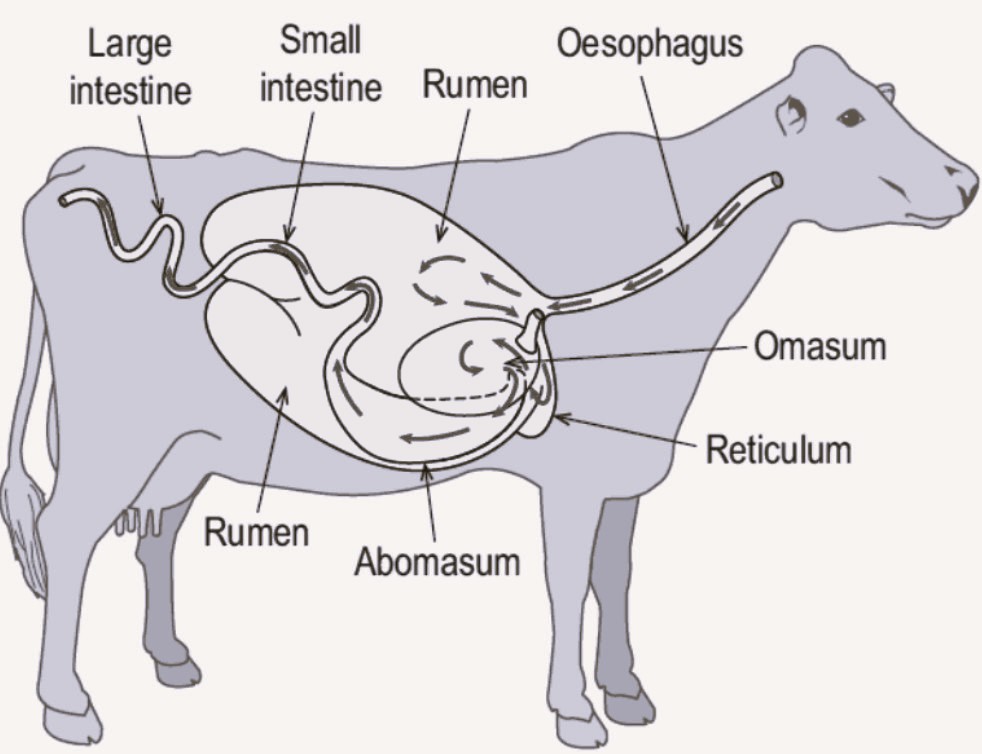
In this section, we will explore the unique digestive process of grass-eating animals, particularly ruminants like cows and buffaloes. Their specialised digestive system allows them to efficiently extract nutrients from cellulose-rich plant material.
Continuous Chewing and Rumen-
- Grass-eating animals, such as cows and buffaloes, are often seen chewing continuously, even when not actively eating.
- This behaviour is a result of their specialised digestive process, which involves quickly swallowing grass and storing it in a part of their stomach called the rumen.
- The rumen serves as a large fermentation chamber where food is partially digested. This partially digested food is called “cud.”
Rumination – The Process of Chewing Cud-
- In a fascinating process known as rumination, ruminant animals regurgitate the cud from their stomach and chew it thoroughly.
- During rumination, the animal brings back small lumps of cud to their mouth and chews them extensively.
- This chewing action helps break down the complex cellulose in the grass into simpler, more digestible components.
Cellulose Digestion with the Help of Rumen Bacteria-
- Grass is rich in cellulose, a type of carbohydrate that is difficult to digest for many animals, including humans.
- Ruminants possess a unique advantage in cellulose digestion due to the presence of specialised bacteria in their rumen.
- These bacteria are capable of breaking down cellulose into more manageable forms, such as simpler sugars.
Caecum in Some Animals-
- While ruminants have the rumen for cellulose digestion, other animals, like horses and rabbits, have a different adaptation.
- These animals have a large sac-like structure called the “caecum,” located between the oesophagus and the small intestine.
- In the caecum, certain bacteria are present, which assist in the digestion of cellulose.
- This adaptation allows these animals to utilize cellulose as a food source, unlike humans.
Adaptations for Food Intake-
- Animals like ruminants and those with a caecum have evolved specialized digestive adaptations to extract nutrients from cellulose-rich plant material.
- These adaptations enable them to efficiently utilize grasses and other fibrous plants as a food source, which would be challenging for animals lacking these adaptations.
Digestion in Organisms without a Mouth and Digestive System-
- While many animals possess digestive systems, there are small organisms that lack a mouth and a traditional digestive system.
- The section hints at another intriguing method of food intake for these organisms, which will likely be discussed in more detail in subsequent chapters.
Also Check- Chewing the Cud- The Ruminant Digestive System
Feeding and Digestion in Amoeba-
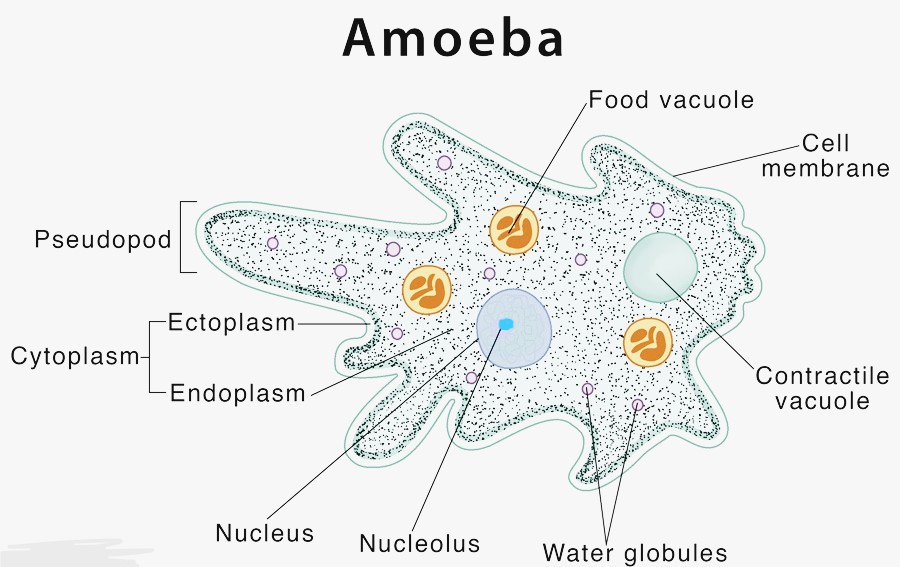
- Amoeba is a microscopic single-celled organism commonly found in pond water.
- Amoeba possesses a cell membrane, a rounded nucleus, and numerous small bubble-like vacuoles in its cytoplasm.
- Amoeba can change its shape and position continually.
- It uses finger-like projections called pseudopodia or false feet for movement and capturing food.
- When Amoeba detects food, it extends pseudopodia around the food particle and engulfs it.
- The food becomes trapped in a food vacuole, where digestive juices are secreted.
- These digestive juices break down the food into simpler substances.
- The digested food is gradually absorbed and used for growth, maintenance, and multiplication of Amoeba.
- Undigested residue is expelled outside the cell through vacuoles.
Digestion in Animals-
- The basic process of digestion and the release of energy from food is similar in all animals.
- Food is broken down into simpler substances through digestion, and these substances are absorbed for various bodily functions.
- In a later chapter, you will learn about how absorbed food is transported to different parts of the body.
Amazing Fact – Starfish Feeding
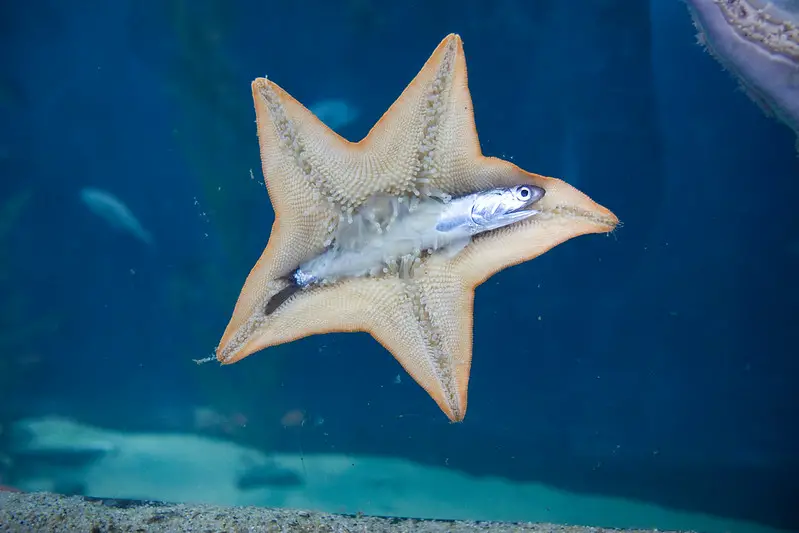
- Starfish are fascinating marine creatures known for their unique feeding methods.
- They primarily feed on animals that have hard shells made of calcium carbonate, such as certain types of mollusks and bivalves.
- To access the soft animal inside the shell, a starfish employs a remarkable feeding strategy.
- The starfish uses its tube feet and arms to grasp and open the shell of its prey.
- Once the shell is open, the starfish extrudes its stomach through its mouth and into the shell of the prey animal.
- The stomach then envelops the soft tissues of the prey, and digestive enzymes are released to break down the prey’s body into simpler substances.
- After the digestion process is complete, the starfish retracts its stomach back into its body, leaving behind only the indigestible parts of the prey.
- This method allows the starfish to feed on animals protected by hard shells, making them efficient predators in their marine habitats.
Also Check – Chapter 2 – NUTRITION IN ANIMALS -Class 7 – Complete Notes
Also Check – Chapter 2- Nutrition in Animals Class 7 Worksheet – Fill in the Blanks
Also check – Chapter 2- Nutrition in Animals Class 7 Worksheet – Multiple-Choice Questions (MCQs)
Also Check – Chapter 2- NUTRITION IN ANIMALS -Class 7 Question and Answer (Long)
Also Check – Chapter 2- NUTRITION IN ANIMALS -Class 7 Question and Answer (Short)


